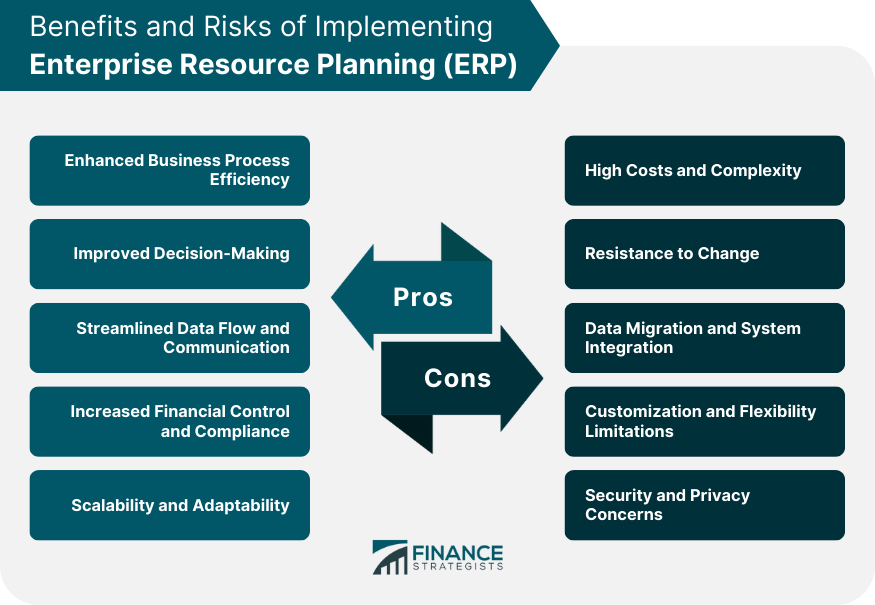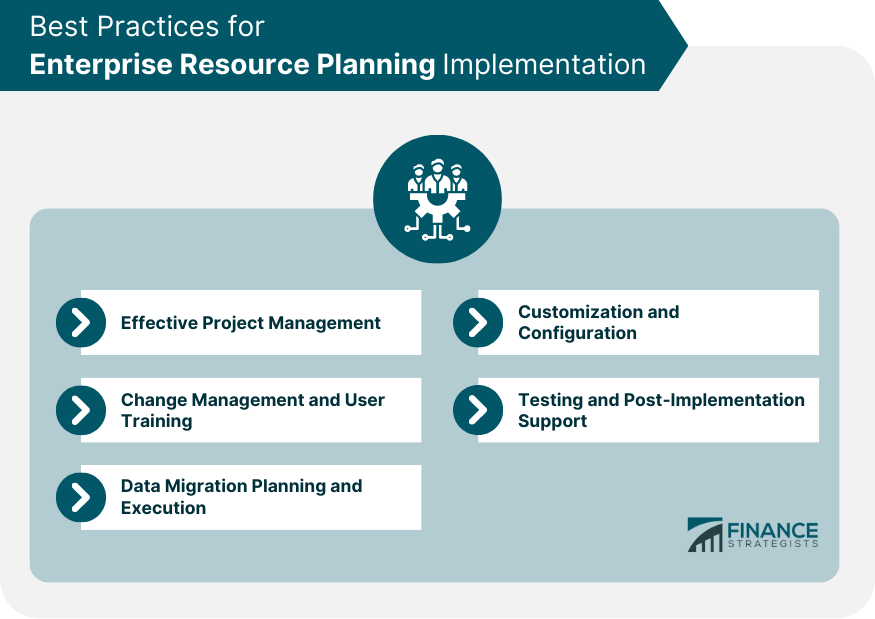Enterprise resource planning (ERP) is a software system that helps organizations manage their business processes, including financial management, supply chain management, human resources management, and customer relationship management. An ERP system integrates all of the organization's core business functions and processes into a single, unified system. This allows for the automation and optimization of business operations, streamlining workflows and reducing the risk of errors and redundancies. With an ERP system, organizations can manage their resources more effectively, make more informed decisions, and respond to changes in the business environment more quickly. ERP systems are widely used by large organizations and can be customized to meet specific business needs. ERP systems typically include core modules that address essential business functions. Some of these modules are: This module helps organizations manage their financial transactions, including accounts payable, accounts receivable, general ledger, and budgeting. This module facilitates the management of sales processes, such as order processing, invoicing, and shipping. This module handles employee-related tasks, including payroll, time and attendance, recruitment, and performance management. This module assists in managing production processes, inventory control, and quality management. Apart from core modules, ERP systems may also feature extended modules to address specific business needs. Some of these modules include: This module helps organizations manage customer interactions, such as marketing, sales, and support. This module enables organizations to optimize their supply chain processes, including procurement, logistics, and inventory management. This module assists organizations in managing projects, including planning, resource allocation, and progress tracking. This module provides organizations with analytical tools to support decision-making, such as reporting, data visualization, and predictive analytics. A critical aspect of ERP systems is their ability to integrate and share data across modules, ensuring consistency and accuracy. ERP systems offer various benefits to organizations, such as: By automating and streamlining operations, ERP systems can significantly improve an organization's overall efficiency. ERP systems provide real-time data and analytics, enabling informed decision-making and faster response times. By integrating various business processes, ERP systems facilitate seamless data flow and improve communication between departments. ERP systems can help organizations maintain better financial control by providing accurate and timely financial data, enabling them to comply with regulations and standards. ERP systems can be scaled and adapted to accommodate an organization's changing needs as it grows or evolves. Despite the numerous benefits, ERP implementation can also present challenges and risks, such as: Implementing an ERP system can be expensive and complex, requiring significant investments in hardware, software, and training. Employees may resist the changes brought about by an ERP system, leading to reduced productivity and morale. Migrating data from legacy systems to an ERP system and integrating the new system with existing applications can be challenging and time-consuming. Organizations may face limitations in customizing an ERP system to meet their unique requirements or adapting it to changing business needs. ERP systems may pose security and privacy risks if not adequately protected, as they store and process sensitive data. Choosing the right ERP software is crucial for the success of an ERP implementation project. Organizations should consider the following factors: While on-premise ERP solutions offer greater control and customization, cloud-based solutions can provide flexibility, scalability, and cost savings. Organizations must decide between open-source ERP systems, which offer greater customization and lower costs, and proprietary systems, which may provide better support and more extensive features. Evaluating and selecting a reliable ERP vendor is essential to ensure the system meets the organization's needs and receives ongoing support and updates. Organizations should identify the key features and functionalities they require from an ERP system, taking into account the specific needs of their industry and operations. To ensure a successful ERP implementation, organizations should follow these best practices: Assigning a dedicated project manager and establishing clear project goals, timelines, and milestones can help ensure a smooth implementation. Implementing change management strategies and providing comprehensive user training can help address employee resistance and promote adoption of the new system. Thorough planning and execution of data migration processes can help ensure data accuracy and minimize disruptions during the transition to the new system. Configuring and customizing the ERP system to align with the organization's specific needs and processes can enhance the system's effectiveness and user adoption. Conducting rigorous testing of the ERP system and providing ongoing support after implementation can help identify and resolve issues, ensuring optimal system performance. To gauge the success of an ERP system, organizations should consider the following: Establishing KPIs related to efficiency, cost savings, and other relevant metrics can help measure the impact of the ERP system on the organization's performance. Benchmarking the organization's performance against industry standards and implementing continuous improvement initiatives can help optimize the benefits of the ERP system. Conducting an ROI analysis can help organizations determine the financial benefits of their ERP system and justify the investment. Enterprise Resource Planning systems are integral to the success of modern businesses, offering numerous advantages such as increased efficiency, informed decision-making, and improved financial control. However, organizations must carefully navigate the challenges and risks associated with ERP implementation, including high costs, resistance to change, and data migration complexities. To maximize the benefits and ensure a smooth transition, organizations should focus on selecting an appropriate ERP system and adhere to best practices throughout the implementation process. The future of ERP systems will likely be influenced by various factors, including technological advancements, the development of industry-specific solutions, globalization, and sustainability concerns. As the business landscape continues to evolve rapidly, organizations will need to adapt their ERP systems to address emerging needs and challenges. By staying ahead of these trends and continuously improving their ERP systems, businesses can remain competitive and capitalize on the full potential of Enterprise Resource Planning.What Is Enterprise Resource Planning?
Components of Enterprise Resource Planning Systems
Core Modules
Financial Management
Sales and Distribution
Human Resources Management
Manufacturing and Production
Extended Modules
Customer Relationship Management
Supply Chain Management
Project Management
Business Intelligence
Benefits of Implementing Enterprise Resource Planning
Enhanced Business Process Efficiency
Improved Decision-Making
Streamlined Data Flow and Communication
Increased Financial Control and Compliance
Scalability and Adaptability
Challenges and Risks in ERP Implementation
High Costs and Complexity
Resistance to Change
Data Migration and System Integration
Customization and Flexibility Limitations
Security and Privacy Concerns

Enterprise Resource Planning Software Selection
On-Premise vs Cloud-Based ERP Solutions
Open-Source vs Proprietary ERP Systems
Vendor Evaluation and Selection
Key Features and Functionality to Consider
Best Practices for ERP Implementation
Effective Project Management
Change Management and User Training
Data Migration Planning and Execution
Customization and Configuration
Testing and Post-implementation Support

Measuring the Success of Enterprise Resource Planning Systems
Key Performance Indicators (KPIs) for ERP Success
Benchmarking and Continuous Improvement
Return on Investment (ROI) Analysis
Conclusion
Enterprise Resource Planning (ERP) FAQs
Enterprise Resource Planning (ERP) is a software system that integrates various business functions and processes, such as human resources, finance, inventory management, and supply chain management, into a single system. The purpose of ERP is to provide businesses with a unified view of their operations, to improve efficiency, and to optimize decision-making.
An ERP system offers several benefits to businesses, including increased efficiency, improved data accuracy, better decision-making capabilities, streamlined business processes, and enhanced customer service. By integrating various business functions and processes, an ERP system can reduce redundant tasks, minimize errors, and provide real-time data access, which can help businesses to make informed decisions.
An ERP system typically includes modules that cover different business functions such as finance, human resources, sales and marketing, inventory management, and supply chain management. Each module offers specific features such as general ledger accounting, payroll management, customer relationship management, order tracking, and warehouse management, among others.
There are three types of ERP systems: on-premises, cloud-based, and hybrid. On-premises ERP systems are installed and run on a company's own servers and infrastructure, while cloud-based ERP systems are hosted and managed by a third-party provider. Hybrid ERP systems combine both on-premises and cloud-based models.
When selecting an ERP system, businesses should consider their specific needs and requirements, such as the size of the organization, the number of employees, the business processes that need to be integrated, and the available budget. Businesses should also consider the functionality and scalability of the ERP system, the vendor's reputation and track record, and the level of support and training provided. It's important to conduct a thorough analysis and evaluation of several ERP systems before making a final decision.
True Tamplin is a published author, public speaker, CEO of UpDigital, and founder of Finance Strategists.
True is a Certified Educator in Personal Finance (CEPF®), author of The Handy Financial Ratios Guide, a member of the Society for Advancing Business Editing and Writing, contributes to his financial education site, Finance Strategists, and has spoken to various financial communities such as the CFA Institute, as well as university students like his Alma mater, Biola University, where he received a bachelor of science in business and data analytics.
To learn more about True, visit his personal website or view his author profiles on Amazon, Nasdaq and Forbes.











